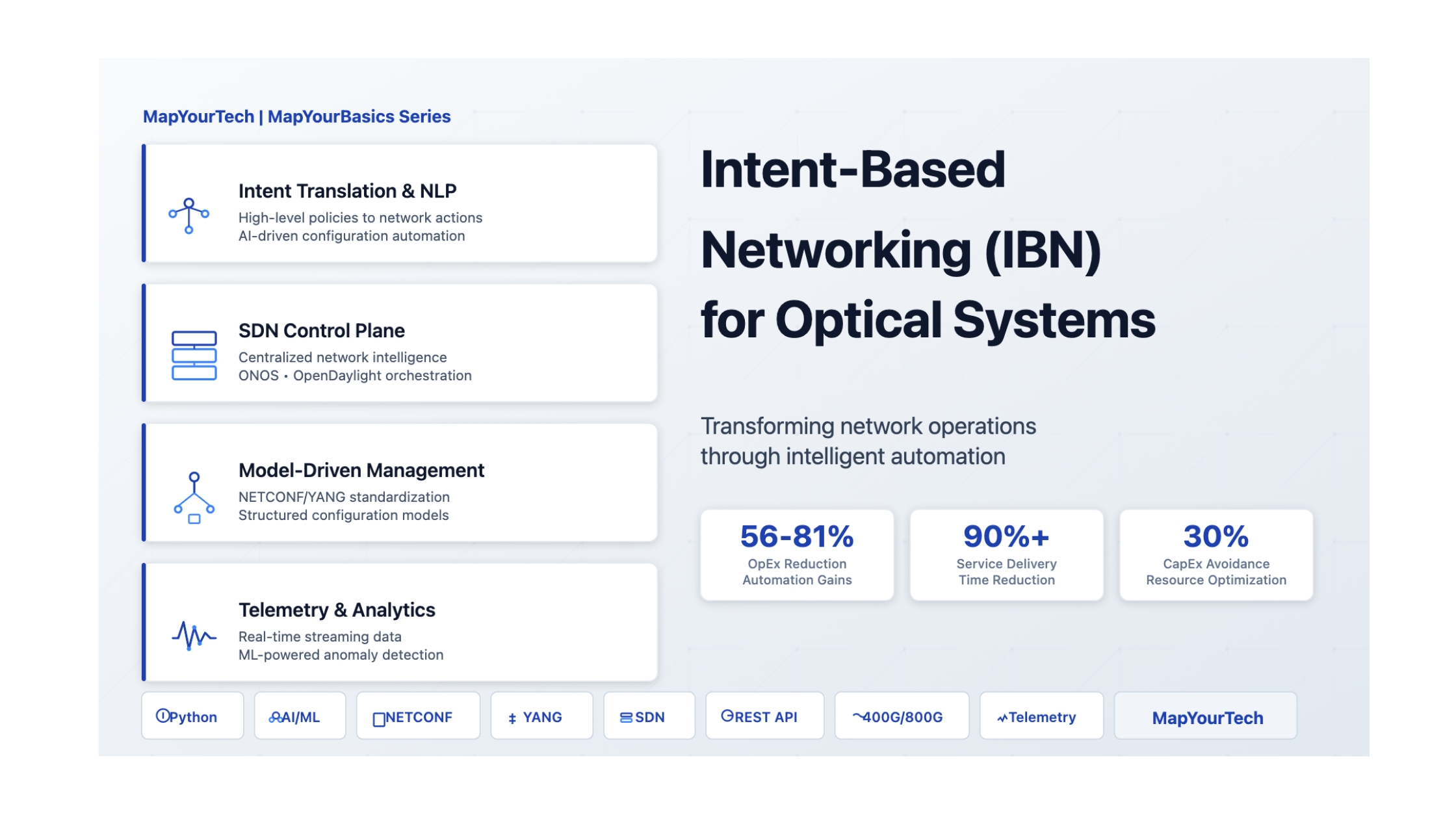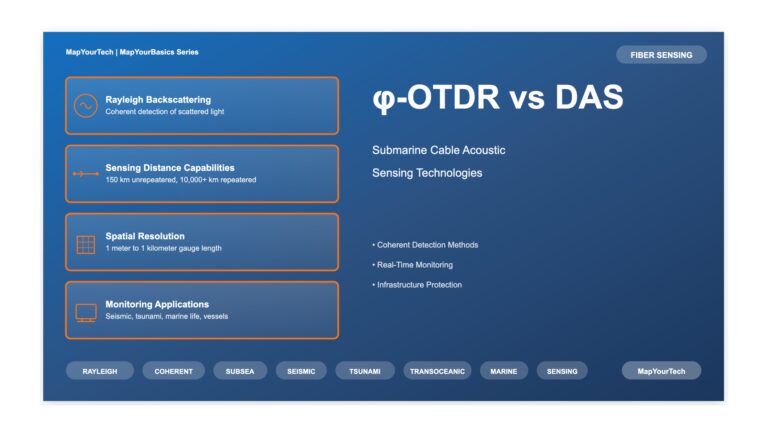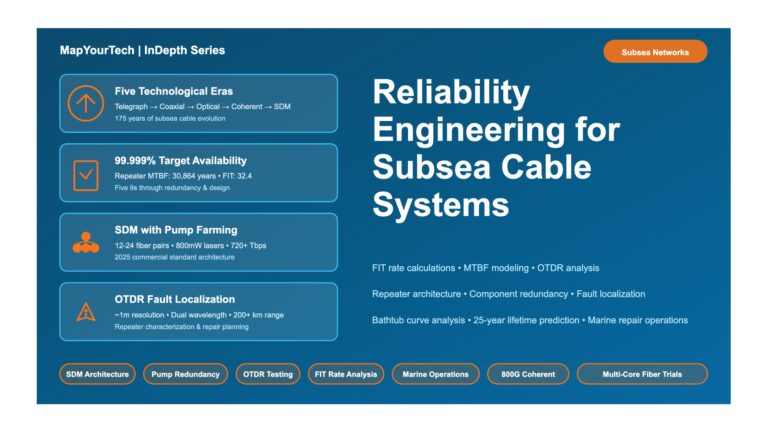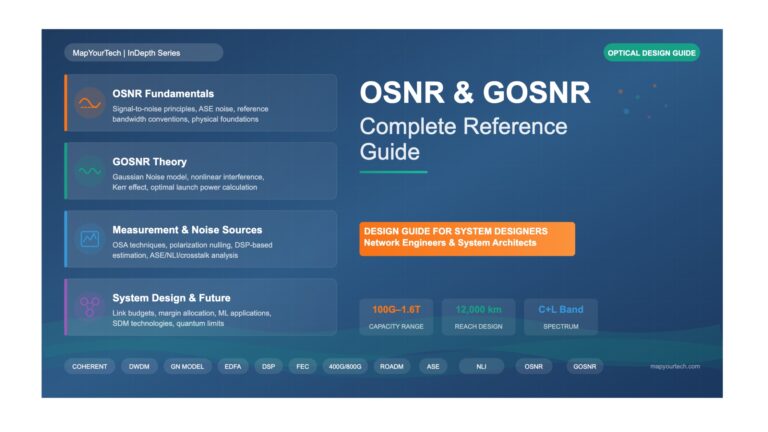7 min read

Intent-Based Networking (IBN) for Optical Systems
Fundamentals & Core Concepts
Intent-Based Networking represents a paradigm shift in how optical networks are designed, configured, and managed. Unlike traditional network management approaches that require operators to configure individual devices with low-level commands, IBN allows network administrators to define high-level business objectives or "intents" that the network automatically translates into concrete configurations and actions.
At its core, IBN leverages artificial intelligence, machine learning, and software-defined networking principles to create self-configuring, self-optimizing, and self-healing network infrastructures. The system continuously monitors network conditions to ensure alignment with operator-defined goals while automatically adapting to changing requirements and environmental conditions.
Key Principles of Intent-Based Networking
-
Translation and ValidationIBN systems employ Natural Language Processing and AI algorithms to interpret high-level operator commands or policies expressed in natural language or structured formats, translating them into specific network configurations across multiple devices and layers.
-
Automated ImplementationOnce intent is defined, the system automatically generates and deploys the necessary configurations across optical network elements, eliminating manual configuration errors and reducing deployment time from hours to minutes.
-
Continuous VerificationIBN platforms continuously monitor network state to verify that actual behavior aligns with intended outcomes, triggering corrective actions when deviations are detected.
-
Dynamic AdaptationThe network automatically adjusts configurations in response to changing conditions, traffic patterns, or performance requirements without human intervention.
Evolution from Traditional Network Management
Traditional optical network management relied heavily on manual configuration using command-line interfaces specific to individual vendors. Network engineers needed deep expertise in device-specific syntax and protocols, making changes time-consuming and error-prone. Configuration time typically averaged 30 minutes per device, with significant risk of human error.
The integration of Software-Defined Networking introduced centralized control planes that separated network intelligence from data forwarding functions. SDN controllers like ONOS and OpenDaylight provided programmatic interfaces through REST APIs and protocols like NETCONF, enabling automated configuration management. However, operators still needed to specify detailed network behaviors and configurations.
IBN builds upon SDN foundations by adding an abstraction layer that allows operators to define business objectives rather than technical implementations. The system automatically determines how to achieve these objectives by analyzing network topology, capacity, performance metrics, and service level agreements.
Enterprise networks and service providers are increasingly adopting IBN to maintain optimal performance for latency-sensitive applications. In one deployment scenario, an operator defines an intent for low-latency service for real-time video applications, and the IBN system automatically configures necessary optical paths and reroutes traffic as needed to maintain performance targets.
Intent-Based Networking Workflow
End-to-end process flow from intent capture through automated deployment and continuous verification.
Mathematical Framework & Optimization
Intent-Based Networking for optical systems relies on sophisticated mathematical models and optimization algorithms to translate high-level intents into actionable network configurations. The framework encompasses Quality of Transmission prediction, resource allocation optimization, and multi-objective decision-making processes.
Quality of Transmission (QoT) Estimation
Machine learning models predict QoT for candidate lightpaths before establishment, enabling proactive path selection and resource allocation. Both classification approaches (feasible/infeasible paths) and regression techniques (predicting specific metrics like Signal-to-Noise Ratio or Bit Error Rate) are employed.
Supervised learning algorithms including Support Vector Machines, Random Forests, and Artificial Neural Networks analyze link parameters such as fiber characteristics, amplifier spacing, chromatic dispersion, polarization mode dispersion, and nonlinear effects to estimate transmission quality. These models are trained on historical network data and simulation results to achieve high prediction accuracy.
Deep learning architectures, particularly Multi-Layer Perceptrons and Convolutional Neural Networks, excel at capturing complex, nonlinear relationships between physical layer impairments and signal quality. These models can process high-dimensional feature spaces derived from optical monitoring data to predict OSNR, BER, and other critical performance metrics.
Routing and Resource Assignment
IBN systems optimize routing decisions across multiple dimensions including path length, available spectrum, latency requirements, and reliability constraints. For wavelength division multiplexed networks, the Routing and Wavelength Assignment problem involves selecting optimal paths and wavelength allocations that satisfy service requirements while maximizing network efficiency.
Reinforcement learning algorithms enable dynamic optimization of routing decisions through continuous interaction with the network environment. These approaches learn optimal policies for wavelength allocation, spectrum assignment, and traffic engineering by receiving feedback in the form of rewards and penalties based on network performance outcomes.
Multi-objective optimization frameworks balance competing objectives such as minimizing latency, maximizing throughput, ensuring reliability, and reducing power consumption. Genetic algorithms, particle swarm optimization, and deep reinforcement learning methods are employed to find near-optimal solutions in complex, high-dimensional solution spaces.
Predictive Analytics and Anomaly Detection
Unsupervised learning techniques identify patterns and anomalies in network behavior without requiring labeled training data. Clustering algorithms group similar network states, while anomaly detection methods flag unusual patterns that may indicate soft failures or security threats.
Principal Component Analysis and other dimensionality reduction techniques extract salient features from high-dimensional monitoring data, enabling efficient analysis of complex optical signals. These methods reduce computational complexity while preserving critical information for performance assessment and fault detection.
Types & Components
IBN Architecture Layers
Intent-Based Networking architectures for optical systems comprise multiple interconnected layers, each serving specific functions in translating business intent to network reality.
| Layer | Function | Key Technologies | Complexity |
|---|---|---|---|
| Physical Layer | Hardware control and optical signal management | Direct device APIs, optical transceivers | High |
| Transport Layer | Circuit management and wavelength provisioning | NETCONF/YANG models, GMPLS | Medium |
| Service Layer | End-to-end service orchestration | SDN controllers, service APIs | High |
| Management Layer | Operations and policy enforcement | Custom scripts, automation frameworks | Medium |
| Orchestration Layer | Full workflow automation and intent translation | AI/ML engines, NLP processors | Very High |
Core System Components
-
Intent Translation EngineEmploys Natural Language Processing and AI algorithms to parse high-level operator commands and translate them into structured network policies. This component validates intent feasibility against current network capabilities and constraints.
-
SDN Controller IntegrationInterfaces with Software-Defined Networking controllers such as ONOS and OpenDaylight to provide centralized network intelligence and programmatic control. The SDN layer abstracts underlying hardware complexity while exposing standardized APIs for configuration and monitoring.
-
Data Model FrameworkUtilizes YANG data models to provide standardized, structured representations of network configuration and state data. These models enable reliable automation and multi-vendor interoperability while ensuring consistency across the network.
-
Telemetry and Monitoring SystemImplements streaming telemetry that pushes data proactively from network devices rather than relying on traditional polling mechanisms. Collects real-time optical performance monitoring data, configuration changes, and metrics in formats like GPB and JSON for AI/ML analysis.
-
Configuration ManagerManages template-based configuration generation using tools like Jinja2 and YAML. Ensures consistent, validated configurations are deployed across heterogeneous network devices while maintaining version control and audit trails.
-
Workflow EngineOrchestrates end-to-end automation workflows from intent capture through deployment and verification. Coordinates actions across multiple system components while handling error conditions and rollback procedures.
-
AI/ML Analytics PlatformProcesses telemetry data streams to detect anomalies, predict failures, optimize routing decisions, and adapt network behavior to changing conditions. Implements both online learning for real-time adaptation and offline training for model improvement.
Communication Protocols and Interfaces
NETCONF serves as the primary protocol for network device configuration, providing transactional semantics and robust error handling. YANG models define the structure and semantics of configuration and operational data, enabling standardized interactions across multi-vendor environments.
REST APIs provide programmatic access to SDN controller functions and network management systems, facilitating integration with external applications and orchestration platforms. These interfaces support both synchronous and asynchronous operations, enabling efficient handling of long-running network provisioning tasks.
Streaming telemetry protocols push real-time performance data from network elements to centralized collectors, providing the low-latency, high-fidelity data streams required for effective AI/ML-driven automation. This approach significantly reduces monitoring overhead compared to traditional SNMP polling methods.
Figure 1: Intent-Based Networking Architecture Stack
Complete layered architecture showing the relationship between intent definition, policy translation, SDN control, and optical infrastructure.
Effects & Impacts
Operational Benefits
Implementation of Intent-Based Networking in optical systems delivers transformative improvements across multiple operational dimensions. Studies have quantified significant operational expenditure savings of 56-81% in specific automation scenarios, alongside capital expenditure avoidance approaching 30% through optimized resource utilization.
Service provisioning time decreases dramatically from days or hours to minutes through automated configuration and validation. Manual configuration tasks that previously consumed 30 minutes per device are now completed in seconds with substantially reduced error rates. This acceleration directly impacts time-to-market for new services and customer satisfaction metrics.
-
Reduced Operational ComplexityIBN abstracts the underlying hardware complexity, allowing operators to focus on service logic and business objectives rather than device-specific configurations. This simplification reduces the learning curve for network operations staff and enables faster onboarding of new team members.
-
Enhanced Network AgilityAutomated intent-driven provisioning enables rapid deployment of new services and dynamic response to changing business requirements. Networks can adapt to evolving traffic patterns and application demands without extensive manual reconfiguration.
-
Improved Service ReliabilityContinuous verification mechanisms ensure network behavior remains aligned with intent, automatically detecting and correcting configuration drift. Self-healing capabilities minimize service disruption by automatically rerouting traffic around failures.
-
Optimized Resource UtilizationAI-driven optimization algorithms maximize network capacity utilization while meeting service level agreement requirements. Dynamic bandwidth allocation and intelligent routing decisions reduce overprovisioning and improve overall network efficiency.
Business Impact
| Impact Area | Traditional Approach | IBN Approach | Improvement |
|---|---|---|---|
| Service Delivery | Days with manual coordination | Minutes with automated provisioning | 90%+ time reduction |
| Configuration Changes | 30 min/device, high error risk | Automated, seconds per device | 95%+ efficiency gain |
| Fault Resolution | 4-8 hours average response | Real-time detection and mitigation | 85%+ downtime reduction |
| Network Optimization | Manual analysis over days | Continuous AI-driven optimization | 20-30% capacity improvement |
Technical Performance Improvements
Machine learning algorithms integrated into coherent optical systems optimize signal recovery and compensate for impairments including chromatic dispersion, polarization mode dispersion, and fiber nonlinearities. These algorithms enable coherent transceivers to adapt dynamically to changing network conditions while maintaining optimal performance.
AI-based traffic engineering analyzes real-time traffic data to predict future demand patterns, automatically adjusting wavelength allocations and rerouting traffic to avoid congestion. Operational deployments have demonstrated network efficiency improvements of 20% or more through intelligent resource management.
Predictive maintenance capabilities analyze historical performance data and environmental conditions to forecast equipment failures before they impact service. This proactive approach reduces unplanned downtime while optimizing maintenance schedules and resource allocation.
Implementation Challenges: Despite compelling benefits, IBN adoption faces hurdles including integration complexity with legacy equipment, trust issues related to AI decision opacity, and organizational inertia around established operational practices. Building confidence requires demonstrating clear return on investment through quantifiable metrics and incremental deployment strategies.
Techniques & Solutions
AI/ML Implementation Approaches
Successful Intent-Based Networking implementations leverage a diverse portfolio of artificial intelligence and machine learning techniques, each suited to specific aspects of network automation and optimization.
-
Supervised Learning for QoT PredictionClassification algorithms including Support Vector Machines, Random Forests, and Artificial Neural Networks determine whether candidate lightpath configurations will meet Quality of Transmission requirements. Regression models predict specific performance metrics such as OSNR, BER, and latency based on link parameters and historical data.
-
Unsupervised Learning for Anomaly DetectionClustering algorithms identify normal operational patterns and flag deviations that may indicate soft failures or degrading performance. These techniques detect subtle issues that traditional threshold-based alarms miss, enabling proactive maintenance before service impact occurs.
-
Reinforcement Learning for Dynamic OptimizationRL agents learn optimal policies for routing, wavelength assignment, and resource allocation through continuous interaction with the network environment. These approaches excel at handling the sequential decision-making challenges inherent in dynamic optical networks.
-
Deep Learning for Complex Pattern RecognitionConvolutional Neural Networks process optical constellation diagrams and eye diagrams for modulation format recognition and signal quality assessment. Recurrent Neural Networks and LSTM architectures handle time-series data for traffic prediction and performance forecasting.
-
Natural Language Processing for Intent TranslationNLP techniques interpret high-level operator commands expressed in natural language or structured formats, translating business objectives into actionable network policies. These systems handle intent ambiguity and validate feasibility against network capabilities.
Automation Framework Design
Effective IBN implementations follow a systematic framework encompassing data modeling, protocol communication, template management, script execution, and validation processes.
The data flow begins with intent capture where operators specify high-level requirements. The system validates these requirements against current network state and capabilities, then applies configuration templates using tools like Jinja2 to generate device-specific configurations. Deployment mechanisms push configurations via NETCONF or REST APIs, followed by automated verification to ensure intended outcomes are achieved.
Python-based automation leverages libraries including NumPy and Pandas for data manipulation, Scikit-learn for machine learning implementations, and frameworks like TensorFlow or PyTorch for deep learning applications. Integration with SDN controllers occurs through REST APIs and specialized libraries for NETCONF communication.
Closed-Loop Automation
Advanced IBN systems implement closed-loop automation where the network continuously monitors its own state, detects deviations from intent, and automatically applies corrective actions without human intervention. This approach represents the ultimate realization of self-optimizing, self-healing network infrastructure.
The closed-loop cycle encompasses monitoring through comprehensive telemetry collection, analysis using AI/ML algorithms to detect anomalies and predict issues, decision-making to determine optimal corrective actions, execution through automated configuration changes, and verification to ensure problems are resolved and intent is maintained.
Self-learning systems adapt to changing network conditions by incorporating new data into their models, enabling continuous improvement in prediction accuracy and optimization effectiveness. These systems balance exploration of new strategies with exploitation of proven approaches to maximize long-term network performance.
Successful IBN deployments follow phased approaches beginning with thorough assessment of automation opportunities, progressing through pilot implementations in controlled environments, and scaling to production networks only after demonstrating clear value and operational readiness. Continuous monitoring of automation effectiveness through well-defined KPIs ensures ongoing optimization and return on investment.
Figure 2: Closed-Loop Automation with AI/ML
Self-healing network architecture with continuous monitoring, analysis, and automated remediation.
Practical Applications
Service Provider Deployments
Global service providers leverage IBN to manage their optical backbone networks spanning thousands of kilometers and supporting multi-terabit capacities. These deployments demonstrate the transformative potential of intent-based automation in real-world operational environments.
-
Dynamic Service ProvisioningOperators implement IBN platforms for metro networks enabling dynamic provisioning of 400G services through APIs without manual intervention. Business customers order bandwidth on-demand, with the system automatically configuring optical paths, allocating wavelengths, and verifying service quality within minutes.
-
Traffic Engineering and OptimizationAI-based traffic engineering systems analyze real-time data to predict demand patterns and automatically adjust wavelength allocations. One major cloud provider achieved 20% efficiency improvement in its 400G optical backbone through continuous optimization of routing and resource allocation.
-
Multi-Layer Service CoordinationIBN platforms enable unified management across optical Layer 1 and higher network layers, optimizing traffic distribution between transport and IP networks. This integration improves overall service performance while simplifying operations through consolidated management interfaces.
Enterprise Network Applications
Enterprise deployments focus on maintaining strict service level agreements for business-critical applications while simplifying network management complexity.
Financial services firms implement IBN to ensure ultra-low latency for trading applications, with systems automatically configuring optimal optical paths and continuously monitoring performance against stringent latency budgets. When performance deviates from targets, the system immediately reroutes traffic through alternative paths.
Healthcare organizations use IBN to guarantee reliable, secure connectivity for telemedicine and medical imaging applications. Intent-driven policies ensure that critical healthcare traffic receives priority treatment while maintaining compliance with regulatory requirements for data protection and availability.
Data Center Interconnect
Hyperscale data center operators deploy IBN for managing high-capacity interconnects between facilities. Real-time dashboards display critical metrics including OSNR, bit error rate, and power levels for each wavelength across 400G and 800G links.
Automated monitoring platforms continuously track latency and jitter metrics, ensuring they remain within service level agreement targets. When performance degrades, the system automatically reroutes traffic to less congested paths, maintaining service quality for latency-sensitive applications including real-time video streaming and online gaming.
Predictive analytics identify potential issues before they impact service, enabling proactive capacity planning and maintenance scheduling. Machine learning models forecast traffic growth patterns, automatically triggering capacity augmentation workflows when utilization thresholds are approached.
Self-Healing Network Implementations
Submarine cable systems and long-haul networks implement self-healing architectures based on SDN and AI integration. When optical transponders experience bit error rate degradation, systems automatically reroute traffic through alternate transponders while notifying operations teams to investigate the degrading component.
Protection switching automation ensures traffic immediately shifts to redundant paths when primary fiber links experience failures. Global cloud providers operate 400G backbone networks with one-plus-one protection where automated systems maintain continuous service for critical applications during fault conditions.
Alarm correlation tools analyze thousands of simultaneous alarms to identify root causes, dramatically reducing mean time to repair. When a faulty amplifier causes OSNR degradation across multiple links, the system pinpoints the root cause, triggers diagnostic tests, and suggests optimal rerouting options to minimize service impact.
Network Function Virtualization Integration
IBN platforms integrate with Network Function Virtualization environments to enable end-to-end service automation spanning both physical optical infrastructure and virtualized network functions. Operators deploy flexible, scalable services by combining automated optical provisioning with on-demand instantiation of virtualized routing, security, and application delivery functions.
This convergence of optical network automation and NFV enables service providers to rapidly launch new offerings while optimizing infrastructure costs. Intent-driven policies automatically coordinate resource allocation across physical and virtual domains, ensuring consistent service delivery and performance.
Emerging applications include integration with quantum communication systems for ultra-secure key distribution, AI-driven optimization of 800G and terabit coherent systems, and autonomous network management for space division multiplexing and multi-core fiber deployments. The convergence of IBN, edge computing, and 5G transport networks will enable new classes of latency-sensitive applications requiring seamless coordination between wireless access, optical transport, and cloud resources.
Unlock Premium Content
Join over 400K+ optical network professionals worldwide. Access premium courses, advanced engineering tools, and exclusive industry insights.
Already have an account? Log in here




